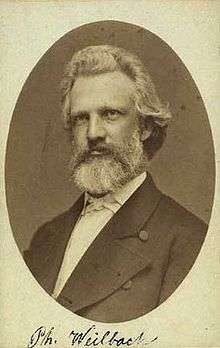Philip Weilbach
Philip Weilbach (5 August 1834, Usserød – 22 November 1900, Copenhagen) was a Danish art historian and encyclopedist. He is remembered above all for his pioneering work on the early editions of the biographical dictionary, Weilbachs Kunstnerleksikon (Weilbach's Artists' Lexicon).

Early life
Son of Johan Philip Weilbach who ran a clothing factory in Usserød north of Copenhagen, Weilbach graduated from Borgdyd School on the Copenhagen island of Christianshavn in 1852. He then studied esthetics and history of art but did not take final examinations. From 1860 to 1862, he was in Rome as secretary to the Danish consul and became a member of the Scandinavian Association.[1]
Career
On returning to Denmark, he published De berømte Broncedøre for Hovedindgangen til Baptisteriet i Florens, udførte af Lorenzo Ghiberti (1862) about Lorenzo Ghiberti's bronze doors in the Baptistry of Florence Cathedral. He assisted the literary critic Clemens Petersen and also befriended the Norwegian author Bjørnstjerne Bjørnson for a while, leading in 1870 to a collection of articles he published as Konst og Æsthetik (Art and Esthetics). In 1872, he wrote a biography of the painter Christoffer Wilhelm Eckersberg titled Maleren Eckersbergs Levned og Værker.[1]
In 1883, he followed Julius Lange as secretary of the Royal Danish Academy and also became the institution's librarian, a position he maintained for the rest of his life. H.[1][2]
While his work as a critic was less notable than that of Lange, his contributions to the history of architecture were more successful. These included Hvem har bygget Frederiks Hospital? (Who Built Frederik's Hospital?) in 1899 and En bygning af Harsdorff i Trondhjem (A Building by Harsdorff in Trondheim) in 1901. However, he is remembered above all for his work on the first and second series of Denmark's biographical dictionary of artists and architects known as Weilbachs Kunstnerleksikon, first published in 1877–1878[3] and again in 1896–1897.[4] These solid works are based on rich background material as well as on archival sources and include personal contributions from artists who were still living at the time.[1] In 1892 Weilbach became a Knight of the Order of the Dannebrog.
References
- "Philip Weilbach", Dansk Biografisk Leksikon; retrieved 8 October 2012 (in Danish language).
- Fabritius, Elisabeth (1 February 2005). The ambassador John L. Loeb Jr. Danish art collection. J.L. Loeb. p. xxxii. ISBN 978-0-9762043-0-5. Retrieved 8 October 2012.
- Avery, Kevin J. (2002). American Drawings and Watercolors in the Metropolitan Museum of Art. Metropolitan Museum of Art. p. 297. ISBN 978-1-58839-060-8. Retrieved 8 October 2012.
- Denmark. Danish Ministry for Foreign Affairs and the Danish Statistical Deptartment. 1964. p. 578.